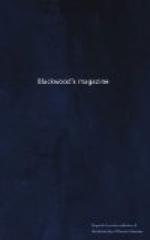Great advances have been recently made in our knowledge of the sea-going Salmonidae. Indeed, all the leading facts of primary importance in the history of their first development and final growth are now distinctly known, and have lately been laid before the public in the form both of original memoirs in our scientific journals, and the transactions of learned societies, and of more popular abstracts in various literary works. We ourselves discussed the subject in this Magazine, with our accustomed clearness, a couple of months ago; and we shall therefore not here enter into the now no longer vexed question of the nature of parr and smolts,—all doubt and disputation regarding the actual origin and family alliance of these fry, their descent from and eventual conversion into grilse and salmon, being finally set at rest to the satisfaction of every reasonable and properly instructed mind. We consider it, however, as a good proof of the natural sagacity and observant disposition of our present author, that he should have come to the same conclusion several years ago, regarding the habits and history of salmon-fry, as that so successfully demonstrated by Mr Shaw. Mr Scrope dwells with no unbecoming pertinacity on this point; but he shows historically, while fully admitting the importance and originality of that ingenious observer’s experimental proceedings, that he had, in the course of his own private correspondence and conversation, called the attention of Mr Kennedy of Dunure as a legislator, and of Sir David Brewster as a skilled interpreter of natural phenomena, to various facts corresponding to those which have been since so skilfully detailed by Mr Shaw.
Our author, though well acquainted with the sporting capabilities of all parts of Scotland, here confines himself to the lower portions of the Tweed, more than twelve miles of which he has rented at different times. We in some measure regret that one so able to inform us, from his extensive experiences regarding the nature and localities of the first-rate though rather precarious angling for salmon which may be obtained in the northern parts of Scotland, should not have contrived to include an account of the more uproarious Highland streams and placid lakes frequented by this princely species. With all our admiration for the flowing Tweed, of which we have fondly traced the early feeble voice—




